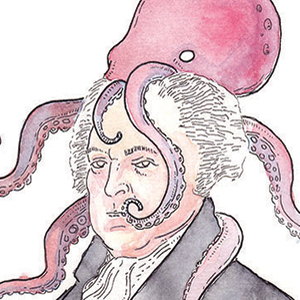A few years ago, after getting laid off from Yahoo, I decided to reinvent my life in the most rational way possible: I drew portraits of America’s vice presidents with octopuses on their heads.
The pictures seemed to have struck a chord with people because they gave me a pile of money on Kickstarter last year to turn the pictures into a book called Veeptopus: Vice Presidents with Octopuses on Their Heads. Life is funny sometimes.
My fascination with the vice presidency started when I was 5, flipping through a copy of Newsweek. Walter Mondale was on the cover, standing sheepishly behind Jimmy Carter. “What does a vice president do?” I asked my mom. “Go to funerals, mostly,” she said. This seemed impossible. How could the No. 2 guy in America just go to funerals?
The answer, as it turns out, is that Founding Fathers just didn’t spend much time thinking about the office. The responsibilities of the vice presidency are described in one vaguely worded sentence in the Constitution (Article 2, Section 1, Clause 6 to be exact). It declares that the veep shall take over upon the president’s “Death, Resignation, or Inability to discharge the Powers and Duties…” That’s it.
In practice, the duties of the veep are maddeningly few. Vice President Charles Dawes, a man of great abilityhe won a Nobel Peace Prize and wrote a No. 1 pop hitsummed up the job like this: “I can do only two things here [in the Senate]. One of them is to sit up here on this rostrum and listen to you birds talk without the ability to reply. The other is to look at the newspapers every morning to see how the president’s health is.”
The job proved time and again to be purgatory for ambitious men. They were tantalizingly close to the apex of political power yet largely powerless and often ignored. America’s first VP, John Adams, complained, “My country has in its wisdom contrived for me the most insignificant office that ever the invention of man contrived or his imagination conceived.”
The vice presidency was considered so insignificant that President James Madison waited nearly a year to replace George ClintonAmerica’s fourth vice president, not the cosmic funk godafter he died. The office was regularly left veepless as, for whatever reason, vice presidents tended to expire on the job more regularly than presidents during the 19th century. Madison had two die during his tenure.
Even alive, veeps got no respect. Woodrow Wilson’s wife and close advisers kept Vice President Thomas Marshall in the dark for 18 months about the president’s incapacitating stroke, thus denying him the presidency. A clearly ailing FDR only met with Truman once before he died in the middle of World War II. And LBJ so relentlessly teased Hubert Humphrey during Cabinet meetings that the veep reportedly broke down and cried. No wonder then that John Nance Garner, FDR’s first VP, said that the job wasn’t worth a “warm bucket of piss.”
In the past few decades, though, the profile of the office has risen. One reason is the close relationships that recent veeps since Walter Mondale managed to forge with their respective bosses, allowing them to command power within the White House.
Another reason is the 1967 passage of the 25th amendment, which sought to clarify the Constitutional vagueness that dogged two centuries of VPs. The amendment clearly spells out the line of succession and, so as to avoid another Woodrow Wilson farce, provides the mechanism to remove an enfeebled POTUS.
That seemingly prosaic amendment developed a sensational cast since the 2016 election. As the rumors of Trump’s fragile mental health circulate, the internet has fantasized that Pence might use the 25th Amendment to oust the president. Even bloated white supremacist Steve Bannon thinks it’s a possibility. All of a sudden, the VP seems less a joke than an unlikely savior, assuming you feel that a vacuous religious zealot is marginally better than a trigger-happy, unhinged narcissist. The office of the vice presidency might finally just get some respect.
And if that happens, I’ll have to think of some other animal instead of octopuses to bedeck vice presidents.
Cuttlefish, perhaps.
Jonathan Crow lives in Santa Clara. The above was excerpted from his new illustrated history of American vice presidents, Veeptopus.
Veeptopus: Vice Presidents With Octopuses on Their Heads
jonathan-crow.com



